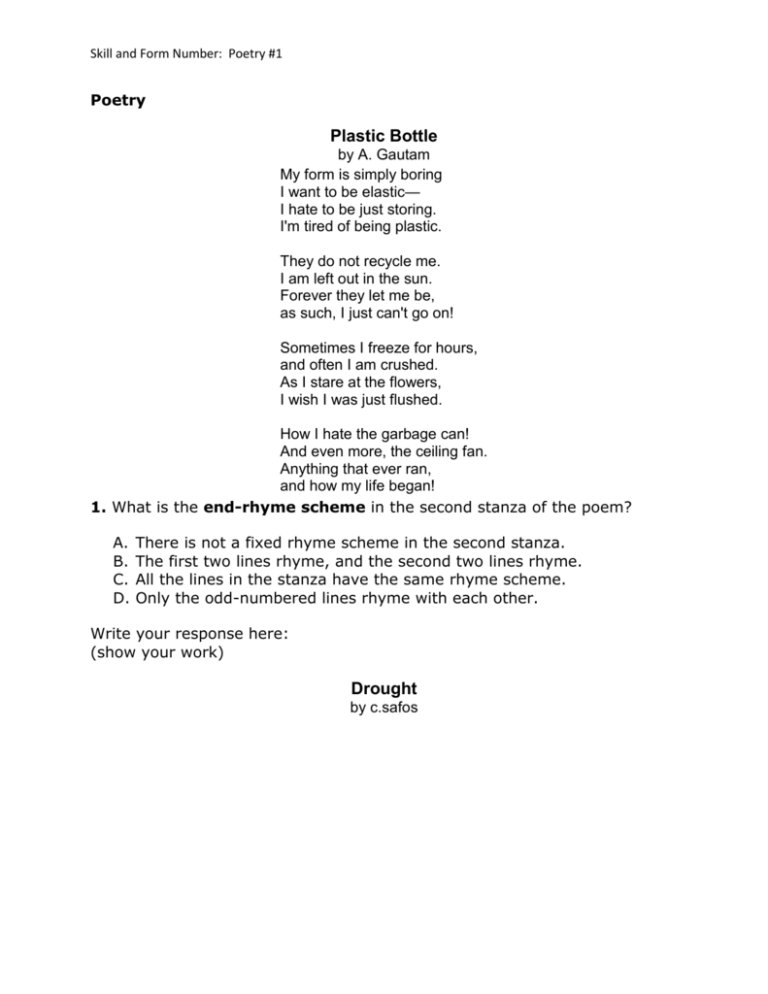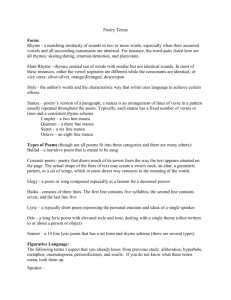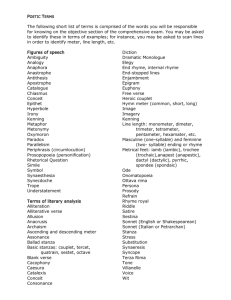
Skill and Form Number: Poetry #1
Poetry
Plastic Bottle
by A. Gautam
My form is simply boring
I want to be elastic—
I hate to be just storing.
I'm tired of being plastic.
They do not recycle me.
I am left out in the sun.
Forever they let me be,
as such, I just can't go on!
Sometimes I freeze for hours,
and often I am crushed.
As I stare at the flowers,
I wish I was just flushed.
How I hate the garbage can!
And even more, the ceiling fan.
Anything that ever ran,
and how my life began!
1. What is the end-rhyme scheme in the second stanza of the poem?
A.
B.
C.
D.
There is not a fixed rhyme scheme in the second stanza.
The first two lines rhyme, and the second two lines rhyme.
All the lines in the stanza have the same rhyme scheme.
Only the odd-numbered lines rhyme with each other.
Write your response here:
(show your work)
Drought
by c.safos
Skill and Form Number: Poetry #1
The drain snorts
with each gulp
it drinks in.
The water behind the drain
Is the same
As the water in front of the drain.
I imagine behind the drain
Is a world where water is
Valued as much as time.
Only in that place
An hourglass is filled
With giggles from every ocean
When you tip the hourglass over,
You'd swear
The water was molasses.
2. Which phrase from the poem makes the drain seem human?
A.
B.
C.
D.
Valued as much as time
The water was molasses
I imagine behind the drain
The drain snorts
Write your response here:
(show your work)
Peggy Dreams
By A. Gautam
Skill and Form Number: Poetry #1
Peggy sat among the rows of corn
staring at the moon.
She kept the fallen grains in her apron
for some birds to feed.
The rows were neater than her hair
undoing its own beauty.
Her heart was louder than the locusts
swimming among the leaves.
The moon was as pale as her skin
waning in the sky.
The dusk was shorter than the flight
of the descending birds
that emptied her apron every eve,
when Peggy stopped to sit.
Their wings flapped faster than her eyelids
busy in daydreams.
3.
Consider the following descriptions of poetic forms:
A villanelle is 19 lines long, but only uses two rhymes, while also repeating two lines throughout
the poem. The first five stanzas are triplets, and the last stanza is a quatrain such that the rhyme
scheme is as follows: "aba aba aba aba aba abaa."
The tricky part is that the 1st and 3rd lines from the first stanza are alternately repeated so that
the 1st line becomes the last line in the second stanza, and the 3rd line becomes the last line in
the third stanza. The last two lines of the poem are lines 1 and 3 respectively, making a rhymed
couplet.
A sonnet is a fourteen-line poem in iambic pentameter with a carefully patterned rhyme scheme.
The sestina is an old fixed form of poetry, dating as far back as the twelfth century. It consists of
six six-line stanzas and a three-line concluding stanza. The ending words of the first stanza are
repeated throughout each subsequent stanza in a set pattern. The same six words appear in the
concluding three-line stanza, two in each line.
A haiku uses no more than 17 syllables, arranging these often in lines of 5-7-5 syllables and
avoiding similes and metaphors.
Free verse is a style of poetry that is based on cadences that are more irregular than those of
traditional poetic meter. While the basic rhythmic unit of most traditional poetic forms is the foot,
free verse tends to use longer units, such as the line or stanza. Free verse may or may not use
rhyme. When it is used, it tends to follow a looser pattern than would be expected in formal verse.
Which definition most closely reflects the poem?
A. haiku
Skill and Form Number: Poetry #1
B. sestina
C. sonnet
D. free verse
Write your response here:
(show your work)
Little Mr. Tinley
He wished to own a horse,
but he only had a donkey.
And to make things worse,
his donkey was taller
than its master.
For such a small creature
its tail was very long.
Every time it was tied
to rest for the day,
the donkey found a way
to somehow sneak outside.
Mr. Tinley ran to catch it
so nobody could watch
a little lonely man's leash,
and his enormous donkey.
4. Which line from the poem is an example of alliteration?
A.
B.
C.
D.
and to make things worse
the donkey found a way
so nobody could watch
a little lonely man's leash
Write your response here:
(show your work)
Paving Pioneer Square
by Dave McCaul
Skill and Form Number: Poetry #1
The old city is beneath our feet—
buried ruins of the pioneers, our ancestors.
For thirty blocks in every direction
we walk, our everyday footsteps like knocks
upon the doors of their empty, abandoned homes.
Just as one hears the sea inside a washed-up shell,
so, too, the streets roar with echoes of the past.
The cracks in the concrete are windows
thrown open to a lost civilization.
It takes a jackhammer to unearth the treasure.
Drilling through the concrete,
like opening a rusted chest of drawers in the attic
in search of relics.
Beneath the asphalt and tangled steel—
a yellowed photo,
a scrap of moth-eaten fabric,
a handful of dust.
The memories of our grandparents
recalled in our walking.
5. Why does the author compare the streets to a washed-up seashell?
A. to emphasize that people often hear noises coming from beneath the
streets
B. to show that the area beneath the streets was once flooded, but is
now dry
C. to show that the streets make the rushing noise of the ocean like a
seashell
D. to emphasize that the streets once contained something, but are now
hollow
Write your response here:
(show your work)
Rush Hour Kayak
by Dave McCaul
Skill and Form Number: Poetry #1
Driving to work, I am a mole
blind to the world around me
Cocooned inside my car, locked in traffic
white knuckles on the steering wheel, eyes on the clock
Initially, I do not see the kayaker
he is a phantom in the dim light
But then, our paths intersect for a moment
me on the bridge, car engine idling
him on the river, oar cutting the dark waters
I want to trade places with him
feel the droplets of water on my face like a cool baptism
The rhythm of my paddling
tuned to the vigorous thrumming of my heart
Eyes on the far shore, the yawning horizon
clocked by the position of the sun
My car, though warm, is like a prison
Oh, to shiver in the wind!
6. Which line or lines from the poem is an example of a simile?
A. Cocooned inside my car, locked in traffic / white knuckles on the
steering wheel, eyes on the clock
B. Eyes on the far shore, the yawning horizon / clocked by the position of
the sun
C. But then our paths intersect for a moment / me on the bridge, car
engine idling
D. I want to trade places with him / feel the droplets of water on my face
like a cool baptism
Write your response here:
(show your work)
7. Which line or lines from the poem is an example of a metaphor?
A. white knuckles on the steering wheel, eyes on the clock
B. me on the bridge, car engine idling / him on the river, oar cutting the
dark waters
C. Driving to work, I am a mole / blind to the world around me
D. The rhythm of my paddling / tuned to the vigorous thrumming of my
heart
Write your response here:
(show your work)
Skill and Form Number: Poetry #1
Foolish Love
Ding-dong, my heart bell rings,
when Lily walks by me.
Oh, how my eardrums roll,
when Lily speaks to me.
Tick-tick, my pulse beats loud
When she says,"Hello, Billy!"
I think of how my name
rhymes with hers, and how
her smile is precious.
Before I say a word,
she walks past the big tree.
Ding-dong, my heart bell rings
I have made a fool of me!
8. What word in the poem above is an example of onomatopoeia?
A.
B.
C.
D.
bell
pulse
heart
ding
Write your response here:
(show your work)
9.
Tyra was certainly losing it. She did not understand why everyone did not respect
books like she did. When she had loaned her favorite book, The Alchemist, to Jonah,
she had not expected him to disrespect it like that. The pages had aged in two weeks,
and the cover was torn in more than one spot. The misused and abused state of the
book confused Tyra.
"Next time you borrow a book, please treat it well," Tyra told Jonah and walked away
with her battered book.
In this story, the author uses rhyme
A.
B.
C.
D.
in
in
in
in
the
the
the
the
concluding sentence that describes Tyra's book.
sentence that describes the book as Tyra's favorite.
comment Tyra makes to Jonah about the book.
sentence that describes the battered book.
Write your response here:
(show your work)
Skill and Form Number: Poetry #1
10.
June has come too soon
The days are too long
I wait forever for the moon
The sun is angry now
With scorching rays like bows
I face its wrath somehow
The worst, school is out
And you are out of sight
I sit alone and fidget about
The pool is not yet cool
My best friend is away
I am bored and feel like a fool
Which of these is true about this poem?
A.
B.
C.
D.
The second and third lines of each stanza rhyme.
The even lines of each stanza end in the same rhyme.
The first and third lines of each stanza rhyme.
Every line in each stanza ends in the same rhyme.
Write your response here:
(show your work)
Skill and Form Number: Poetry #1
Answers
1. D
2. D
3. D
4. D
5. D
6. D
7. C
8. D
9. D
10. C
Explanations
1. The reader can tell by looking at the second stanza that the oddnumbered lines rhyme with each other. Thus, the odd lines end with an "e"
sound: me, be. These end rhymes are examples of perfect rhymes.
2. Personification is a figure of speech in which things are endowed with
human qualities or are represented as possessing human form. In this case,
the object being personified is the drain. A drain cannot really snort the way
a human does, but the sound a drain makes can sound similar to many of
the noises humans make.
3. One major characteristic of free verse poems is that they don't have a set
number of lines and usually vary in length. They are also less formal and
don't use as many rhymed words. If there are words that rhyme, they are
not done in a specific pattern as they are in sonnets, and sestinas. Also as
free verse poems do not have a fixed number of syllables as they are in
sonnets, sestinas and haikus.
4. Alliteration is the repetition of the initial consonant. There should be at
least two repetitions in a row.
For example: Peter Piper picked a peck of pickled peppers. The first letter, P,
is a consonant. It is repeated many times. (If you use a vowel sound rather
than a consonant, it is assonance.)
In this case, the repeated consonant sounds have an L sound. They are
little, lonely, and leash.
Skill and Form Number: Poetry #1
5. Similes compare two unlike things. Poets and authors show the
comparison by using the words "like" and "as." A seashell is a hard,
protective layer that was once inhabited by a sea creature. When it is
washed up on the beach, it is usually empty. The author is trying to show
how the streets are a hard, protective layer covering an empty space where
people once lived.
6. Similes compare two unlike things. Poets and authors show the
comparison by using the words "like" and "as." In this case, two things are
being compared: the feel of water on the speaker's face and a baptism. A
baptism is a ritual for first-time members of a church. It is the beginning of
a new way of life. The speaker is saying that the feel of the water on his face
would be like starting a new life.
7. A metaphor is a figure of speech that compares two different things.
Metaphors do not use the words "like" and "as." In this case, the comparison
is between the speaker and a mole. Moles are animals that have a very
weak sense of sight. The speaker feels he is like a mole when he drives to
work because he does not notice the world around him.
8. Onomatopoeia is the formation or use of words that imitate the sounds
associated with the objects or actions they refer to. In this case, the word
"ding-dong" is meant to sound like the noise bells make when they ring.
Other examples of onomatopoeia are "buzz," "kapow," and "bam!"
9. In this story, the author uses rhyme for emphasis. The sentence "The
misused and abused state of the book confused Tyra" stands out in the
passage because of the use of rhyme. It tells readers how the battered state
of the book upsets Tyra.
10. In this poem, the first and third lines of each stanza rhyme. For
example, look at the last words in each line of the second stanza. The words
"now" and "somehow" have the same ending rhyme, but "bows" does not
rhyme with these two words.
Copyright © 2012 Study Island - All rights reserved.







